Mol cell Bio exam 2 ch 15
1/43
Earn XP
Description and Tags
till slide 26
Name | Mastery | Learn | Test | Matching | Spaced |
|---|
No study sessions yet.
44 Terms
Analogy for how protein synthesis in the side of soul find their way to membrane and organelles
Mail distribution: parcels find their way through ZIP Codes and addresses
Largest to smallest membrane in compartments by percentage volume (8)
Cytosol 54%, mitochondrion 22%, ER with membrane-bound poly ribosomes 12%, nucleus 6%, golgi apparatus 3%, endosome 1%, lysosome 1%, peroxisome 1%
Three functions of the cytosol
Signaling, cytoskeleton, protein synthesis
endosome function
Sorting of endocytosed material
peroxisome function
Oxidation of toxic molecules
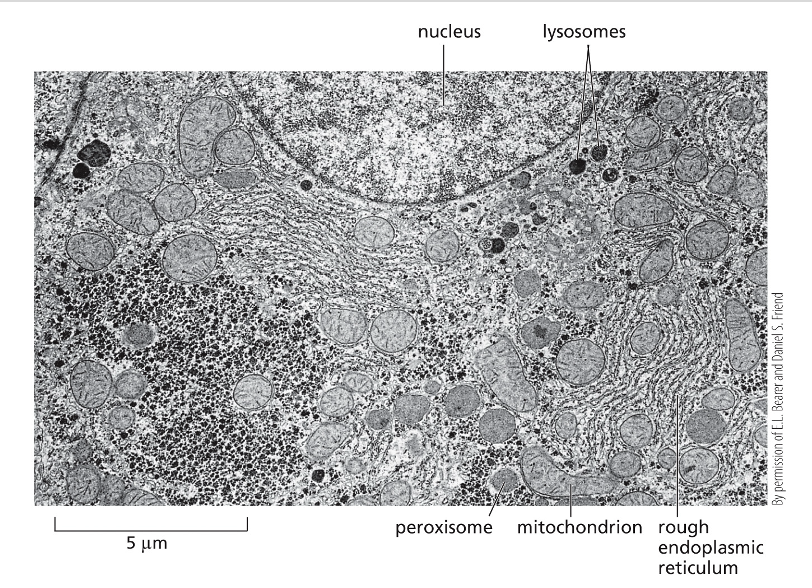
What does this image show?
Electron micrograph of part of a liver cell, small black granules between the compartments are aggregates of glycogen and the enzymes that control its synthesis and breakdown
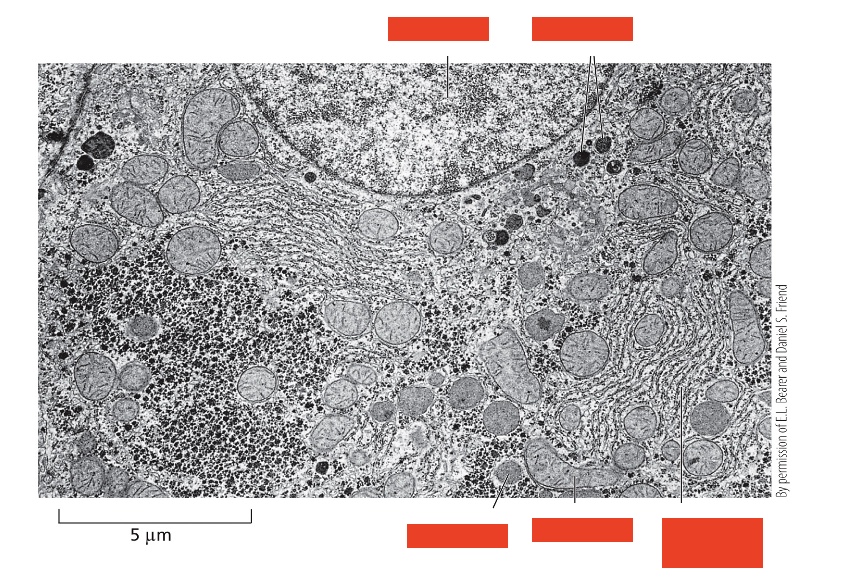
Label the top two
Nucleus, lysosomes

Label the bottom three
Peroxisome, mitochondrion, rough endoplasmic reticulum
Two advantages of compartmentalization
It separates processes, e.g. lysosomes can be extremely acidic, which would be detrimental for the rest of the cytoplasm, processes are able to be concentrated
how did compartmentalization arise? (3 steps)
Endo-symbiotic theory: aerobic prokaryotic cell was phagocytosed by an anaerobic prokaryotic cell, aerobic prokaryotic cell lost surrounding membranes derived from pre-eukaryotic cell, finally you have an early aerobic eukaryotic cell containing a mitochondria with a double membrane
three ways of transport to organelles
Transport through nuclear pores, transport across membranes, transported by vesicles
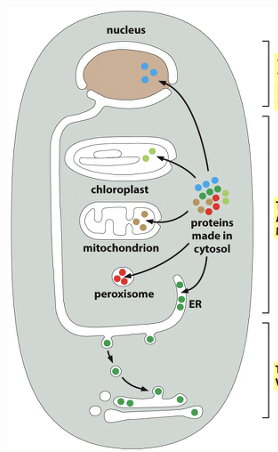
label the transport ways top to bottom
Transport through nuclear pores, transport across membranes, transported by vesicles
what determines where a molecules is transported to, some examples of what signal they can have (3)?
Certain peptides (signal sequences), import into ER, retention in lumen of ER, import into mitochondria
what do proteins have to contain to be transported?
Signal peptides
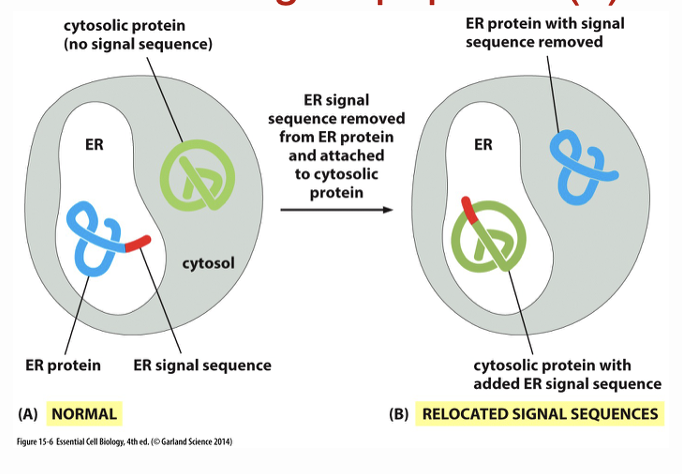
What does this image show?
depending on the red signal peptide a protein is either translocated to the ER or to the cytosol, scientists can use this to make proteins that will enter the ER (picture to the right)
why are nuclear pores important?
Many things have to enter and exit the nucleus
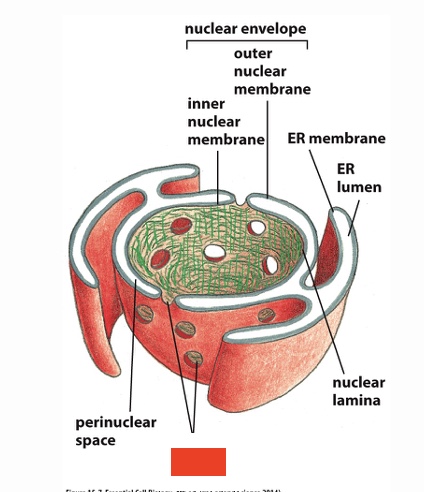
Label
nuclear pores
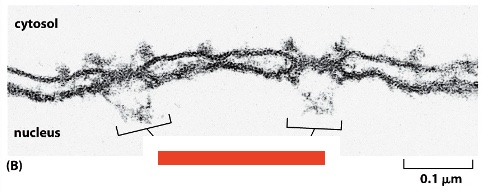
Label
Nuclear pore complexes
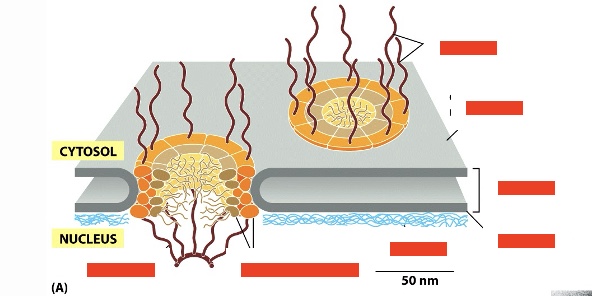
label bottom 4
nuclear basket, pore complex proteins, nuclear lamina, inner nuclear membrane

Label right 3 top to bottom
Cytosolic, fibrils, outer nuclear membrane, nuclear envelope
steps of proteins migrating to the nucleus (1), what do they need (2)?
need nuclear localization signal, nuclear import receptor, together this will lead to delivery from cytoplasm to nucleus
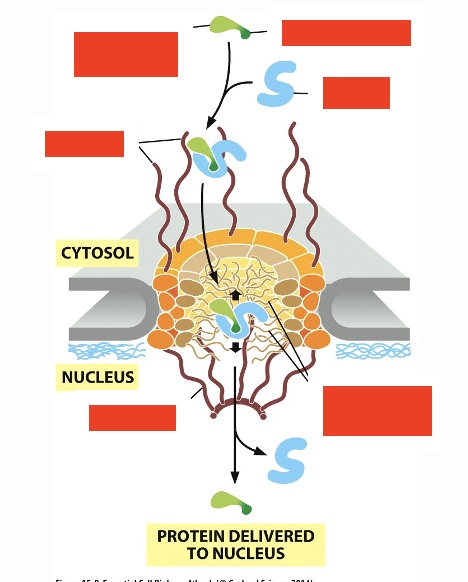
label top three (left to right)
Perspective nuclear protein (cargo), nuclear localization signal, nuclear import receptor

Label bottom three (top then bottom left then bottom right)
cytosolic fibrils, nuclear basket, gel-like meshwork of nuclear fibrils
what drives nuclear transport
Energy by GTP hydrolysis
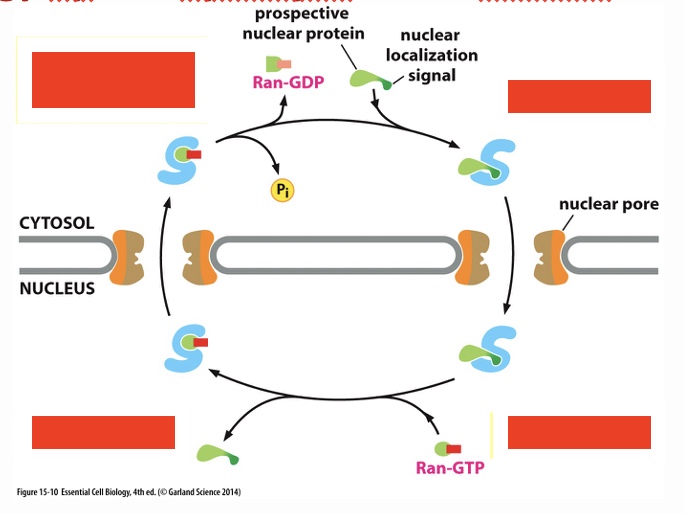
label steps of how GTB hydrolysis provides energy for nuclear transport (start top left, following arrows)
ran hydrolyzes it's bound GTP, ran-GDP dissociates from receptor; protein bines to receptor; ran-GTP binds to receptor; protein delivered to nucleus
How does transport across membranes happen (6 steps)
precursor protein has a signal sequence which binds to import receptors, these receptors deliver the protein to a translocation apparatus at a contact site where mitochondrion’s two membranes are close together, precursor protein snakes in a unfolded state though two protein translocators (1 in each membrane), inside the mitochondrion chaperon proteins pull protein in and prevent backsliding back through the protein translocators, once inside signal peptidase cleaves signal sequence, chaperone proteins released and protein folds and matures
chaperone proteins two functions
prevents protein from preforming its function prematurely, prevents protein from backsliding
How is a protein transported into the ER?
proteins made in the cytoplasm/ER, it binds with an ER signal sequence to a signal receptor particle (SRP), this binds to a receptor in proximity to the protein translator, SRP is displaced which causes the protein to be imported into the ER lumen
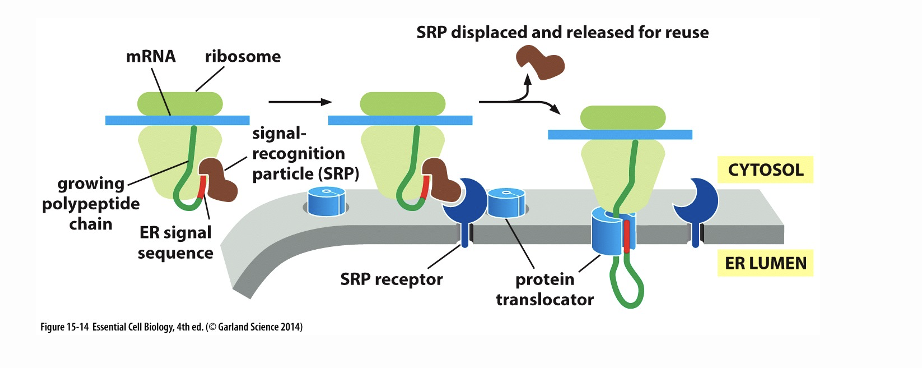
What does this image show?
How to transport into the ER happens
What happens with soluble proteins?
Their signal sequence is cleaved
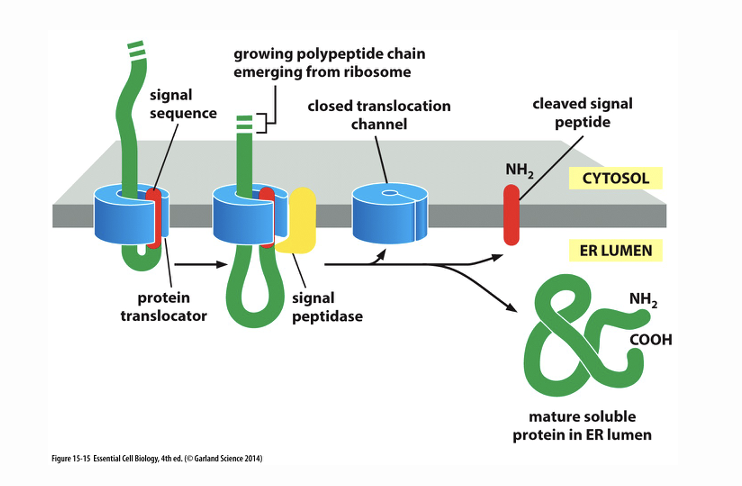
What does this image show
How transport happens with soluble proteins, the signal sequence is cleaved
How does transport happen with membrane proteins? (3 points)
hydrophobic part has to be delivered into the membrane (has a stop transfer sequence and ends with hydrophobic part in membrane), signal peptide is recognized by the protein translator facilitating the import of the peptide, not all of it is transported in since it has a part spanning of the membrane
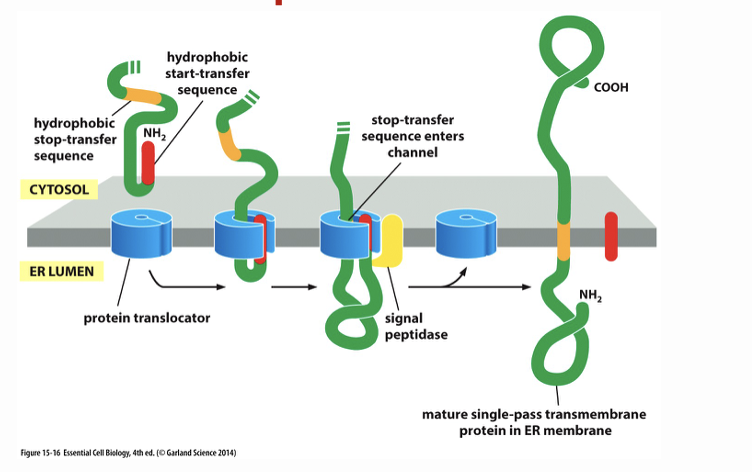
What does this image show?
How does transport across membranes happen with membrane proteins?
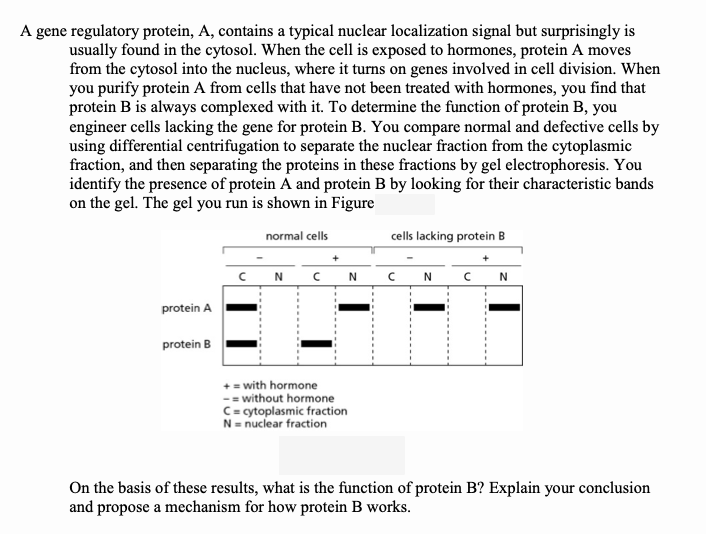

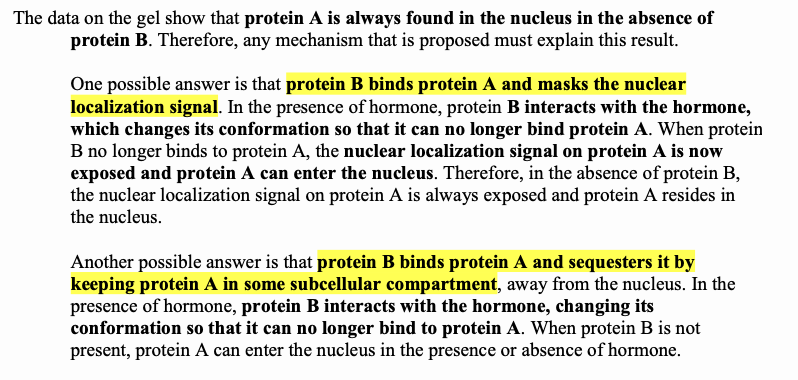
two types of vesicular transport
endocytosis (from outside cell to inside) and exocytosis (buds from inside cell to outside)
Steps post endocytosis (4)
Endocytosis, early endosome (also includes vesicles from golgi apparatus), late endosome, lysosome
Steps pre-exocytosis (3)
Golgi apparatus, transport vesicles, exocytosis
what is vesicular budding driven by?
assembly of a protein coat
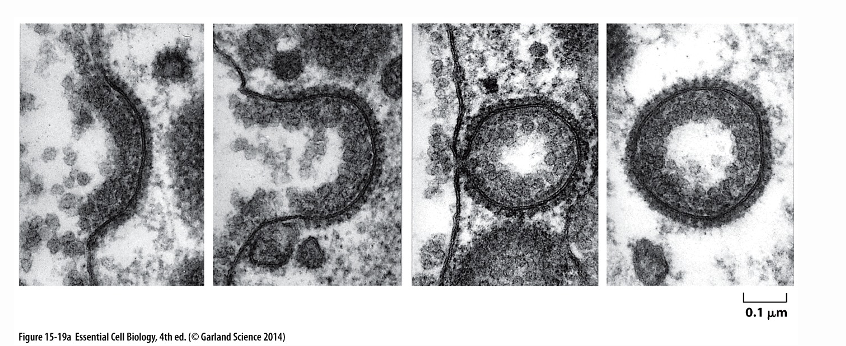
what does this image show?
vesicular budding
what are the components and functions of the protein coat parts (4)
cargo receptor - holds cargo molecules and connects them to adaptin
adaptin - between the cargo receptor and clarithin
clarithrin - assembles into a basketlike lattice structure that distorts the membrane and drives vesicle budding
dynamin - cuts the internally budding vesicle from the membrane
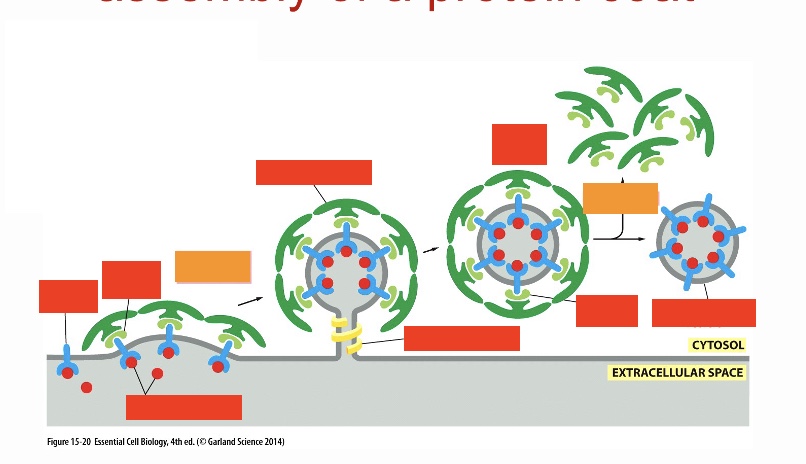
vesicular budding: label the red top row 4 going from left to right
cargo receptor, adaptin, clarithin coat, coated vesicle

vesicular budding: label the red bottom row 4 going from left to right
cargo molecules, dynamin, adaptin, naked transport vesicle

label the orange (steps of what is happening)
vesicle formation, uncoating